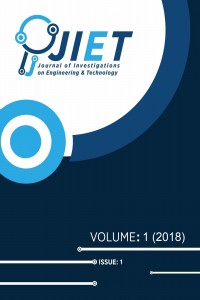Trabzon Uzungöl Sit Alanı için Kaya Islahı Projelendirmesinde Karşılaşılan Zorluklar ve Çözüm Önerileri
Abstract
Türkiye’de kaya ıslahı çalışmalarının önemi her geçen gün daha iyi anlaşılmakta ve yapılan uygulamalar sıklaşmaktadır. Karadeniz Bölgesi, kaya ıslahı çalışmalarına sıkça rastlama imkanı bulunan bölgelerin başında gelmektedir. Özellikle Trabzon’da bulunan Uzungöl ve Sümela Manastırı gibi iki önemli sit alanı olan yerler kaya düşmesi tehlikesi altındadır. Uzungöl, iki önemli özelliği nedeniyle sit alanıdır. Heyelan nedeniyle oluşmuş bir göle sahip olmakla birlikte bu gölün etrafını sarmış olan sık orman ve doğal florası bulunmaktadır. Bölgede yapılacak kaya ıslahı çalışmaları doğal ve tarihi yapıyı bozmadan gerçekleştirilmelidir. Bu bölgelerde, sık ormanların kayaları saklaması ve dağınık yerleşim yapısı kaya ıslahı projelendirmesi yapılırken çok dikkatli arazi çalışmaları gerektirmektedir. Seçilecek kaya ıslah modeli bu hususlar dikkate alınarak geliştirilmelidir.
Sit alanlarının doğal güzellikleri ve tarihi yapıları bozulmadan önce kaya düşmesi tehlikesine karşı ciddi tedbirler alınmaktadır. Bu çalışma, Uzungöl sit alanında yapılacak kaya ıslahı çalışmalarında karşılaşılan problemleri ve çözüm önerilerini içerecektir.
Uzungöl’de üç farklı alanda ve Uzungöl giriş bölgesinde bulunan Alçakköprü mevkisinde kaya düşmesi olayı yaşanmaktadır. Bu çalışma kapsamında, bölgenin turistik yapısını en çok etkileyen Gölbaşı mekiindeki kaya ıslahı ile ilgili sorunlar ve çözüm önerileri verilecektir. Gölbaşı mevkii gölün güney doğu kıyısında bulunmaktadır. Kayaların geldiği yamaç yaklaşık 500 metreden fazla alanı etkilemektedir. Etkilenen alanda birçok turizm yapısı bulunmaktadır. Çalışma içerisinde, Uzungöl mevkiinde kaya ıslahı çalışmalarının zorluklarına detaylı bir şekilde yer verilecektir. Daha sonra bu zorluklara rağmen uygulanabilecek alternatifler değerlendirilecektir. Son olarak sit alanını doğal ve tarihi yapısını etkilemeyecek, en ekonomik ve en makul yöntem belirlenerek sonuç olarak verilecektir.
Keywords
References
- Talobre, J. (1970). Kaya mekaniği ve inşaat işlerinde tatbikatı.
- AFAD, (2015). Heyelan ve kaya düşmesi temel kılavuzu.
- Peckover, F. L. & Kerr, W. G. (1977). Treatment and maintenance of rock slopes on transportation routes. Canadian Geotechnical Journal, 14 (4), 487-507.
- Petje, U., Miko, M. & Majes, B. (2005). Modeliranje skalnih podorov pregled-Modelling of rockfalls. Acta hydrotechnica, 23, 19-9.
- Çelik, M., Seferoğlu, M. T., Seferoğlu, A. G. & Akpınar, M. V. (2016). Rehabilitation methods, challenges, cost benefit analysis of disaster area exposed due to rockfalls in Trabzon province. Doğal Afet ve Afet Yönetimi Sempozyumu (DAAYS’16), 2-4 Mart, Karabük, Türkiye.
- Pierson, L. A., Davis, S. A. & Van Vickle, R. (1990). Rockfall hazard rating system implementation manual. Federal Highway Administration (FHWA) Report, FHWA-OR-EG-90-01.
- Spang, R. M. & Rautenstrauch, R. W. (1988). Empirical and mathematical approaches to rockfall prediction and their practical applications. In Proceedings of the 5th Int. Symp. on Landslides, 2,1237-1243.
Abstract
The importance of rock reclamation studies in Turkey is getting better and
better every day. The Black Sea Region is at the forefront of the areas where
rock breeding studies are frequently encountered. Especially in Trabzon, there
are two important protected areas such as Uzungöl and Sümela Monastery, which
are under the danger of rockfalls. Uzungöl is a natural protected area due to
being a landslide lake and the frequent forests and natural flora that
surrounds it. Rock reclamation work to be done in the region, should be carried
out without disturbing the natural and historical structure. These areas
require very careful field work when rock reclamation is planned due to
frequent forests hiding rocks and scattered settlement structure. The rock
reclamation model to be selected should be developed taking these factors into
consideration. Serious precautions are taken against the danger of rockfalls
before the natural beauties and historical structures of the sites are
deteriorated. This
study includes the problems and solution suggestions in rock reclamation
studies in Uzungol protected area. There are rockfall events in three different
areas in Uzungöl and in Alçakköprü located in the entrance area of Uzungöl. In
this study, problems related to the improvement of rocks in Gölbaşı, which has
the greatest impact on the touristic structure of the region, and suggestions
for solutions will be given. Gölbaşı is located on the south east coast of the
lake. The slope on which the fallrocks affect more than about 500 square meters.
The affected area has many tourism structures. In the study, the difficulties
of the rock reclamation studies in Uzungöl will be explained in detail. Then,
alternatives that can be applied despite these difficulties will be evaluated.
Finally, the most economical and most reasonable method that will not affect
the natural and historical structure of the site will be determined as a
result.
Keywords
References
- Talobre, J. (1970). Kaya mekaniği ve inşaat işlerinde tatbikatı.
- AFAD, (2015). Heyelan ve kaya düşmesi temel kılavuzu.
- Peckover, F. L. & Kerr, W. G. (1977). Treatment and maintenance of rock slopes on transportation routes. Canadian Geotechnical Journal, 14 (4), 487-507.
- Petje, U., Miko, M. & Majes, B. (2005). Modeliranje skalnih podorov pregled-Modelling of rockfalls. Acta hydrotechnica, 23, 19-9.
- Çelik, M., Seferoğlu, M. T., Seferoğlu, A. G. & Akpınar, M. V. (2016). Rehabilitation methods, challenges, cost benefit analysis of disaster area exposed due to rockfalls in Trabzon province. Doğal Afet ve Afet Yönetimi Sempozyumu (DAAYS’16), 2-4 Mart, Karabük, Türkiye.
- Pierson, L. A., Davis, S. A. & Van Vickle, R. (1990). Rockfall hazard rating system implementation manual. Federal Highway Administration (FHWA) Report, FHWA-OR-EG-90-01.
- Spang, R. M. & Rautenstrauch, R. W. (1988). Empirical and mathematical approaches to rockfall prediction and their practical applications. In Proceedings of the 5th Int. Symp. on Landslides, 2,1237-1243.
Details
| Primary Language | Turkish |
|---|---|
| Journal Section | Research Papers |
| Authors | |
| Publication Date | June 30, 2018 |
| Submission Date | February 18, 2018 |
| Acceptance Date | March 22, 2018 |
| Published in Issue | Year 2018 Volume: 1 Issue: 1 |


